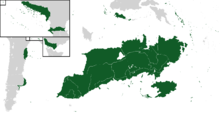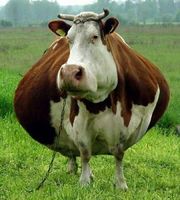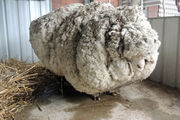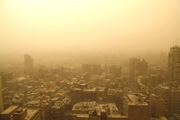Difference between revisions of "Tuvaltastan"
Tuvaltastan (Talk | contribs) |
Tuvaltastan (Talk | contribs) (→Livestock in Tuvaltastan) |
||
| Line 413: | Line 413: | ||
====Livestock in Tuvaltastan==== | ====Livestock in Tuvaltastan==== | ||
| − | The Tuvalti farmers altogether maintain one-third of the area of Tuvaltastan, all of it dedicated to growing food. | + | The Tuvalti farmers altogether maintain one-third of the area of Tuvaltastan, all of it dedicated to growing food. To make raising livestock more effective, many farmers began working together to create a new subspecies of the five major livestock. The current subspecies of livestock have been dubbed "Tuva livestock," and they have lost their ability to defend themselves, since no predators threaten their way of life. Two of the subspecies have also developed to produce large amounts of offspring. It is unknown why. |
Note: All the livestock listed are "Tuva livestock," as mentioned before. | Note: All the livestock listed are "Tuva livestock," as mentioned before. | ||
[[File:Truecow.jpg|thumbnail|left|A Tuva Cow]] | [[File:Truecow.jpg|thumbnail|left|A Tuva Cow]] | ||
=====Cattle===== | =====Cattle===== | ||
| − | Tuva Cattle are a subspecies of the typical cattle that evolved in the farmlands of Tuvaltastan. | + | Tuva Cattle are a subspecies of the typical cattle that evolved in the farmlands of Tuvaltastan. When mature, the cattle have 50% more meat than the typical cattle. The females' udders contain 30% more milk than the typical cattle as well. |
[[File:Truesheep.jpg|thumbnail|right|A Tuva Sheep]] | [[File:Truesheep.jpg|thumbnail|right|A Tuva Sheep]] | ||
| Line 434: | Line 434: | ||
=====Overpopulation Issue===== | =====Overpopulation Issue===== | ||
| − | + | Tuva Livestock have become such a popular alternative to traditional livestock in Tuvaltastan, that the populations of these animals is threatening the habitats of the native species. This has resulted in an overpopulation issue, which has been resolved through the exportation of surplus offspring to other countries, the main importing country being Xiopothos, with an occasional large purchase from the Oan Isles. | |
====Crops==== | ====Crops==== | ||
Revision as of 18:53, 27 February 2017
| The Democratic States of Tuvaltastan | ||||
|---|---|---|---|---|
|
||||
| Motto: Nihil Nic Gererentur | ||||
| Anthem: "O Great Tuvaltastan" | ||||
Green: Tuvaltastan ; Light Green: The ACA
|
||||
Regional Map
|
||||
| Capital | Novosibirsk | |||
| Largest city | Shagonar | |||
| Official languages | Codexian and Kostuvian | |||
| Ethnic groups (2015 Estimate) | 77.8% Human
(97% of Humans are of Tuvalt origin) 20.5% Lupine 1.7% Other |
|||
| Demonym | Tuvalt, Tuvalti, Tuva, rarely Tuvaltastani, Tuvaltistani, Tuvaltastanian, Tuvaltistanian | |||
| Government | Parliamentary Republic | |||
| - | High Minister | Abram Sokolov | ||
| - | Commander-In-Chief | Alyona Petrovavich | ||
| - | Vice-Minister | Vladislav Vladisiliev | ||
| Legislature | Parliament | |||
| - | Upper house | Hall | ||
| - | Lower house | Chamber | ||
| Area | ||||
| - | Total | N/A km2 657,750 sq mi |
||
| Population | ||||
| - | 2015 estimate | 23,588,694 | ||
| - | 2010 census | 21,253,092 | ||
| - | Density | N/A/km2 N/A/sq mi |
||
| GDP (nominal) | 2015 estimate | |||
| - | Total | $180.3 billion | ||
| - | Per capita | $12,123.24 | ||
| Gini (2016) | 29.3 low |
|||
| HDI (2016) | .798 high |
|||
| Currency | Tuvalt Kirib (T♅) |
|||
| Date format | MM/DD/YYYY | |||
| Drives on the | the right | |||
| Calling code | +17 | |||
| ISO 3166 code | TUV | |||
| Internet TLD | .tuv | |||
The Democratic States of Tuvaltastan, commonly known as Tuvaltastan (tuːvɔːltʌstæn), is a nation that exists on the continent Aurora that has a border with Xiopothos, Kostromastan, Ethalria, Imperial Fandom, and exists north of Dragonia. Tuvaltastan exists between the latitudes 30 S and 45 S, and between the longitudes 100 E and 140 E. The nation, with a Nominal GDP per capita of $12,123.24, has an estimated population of 23,588,694. Tuvaltastan encompasses the three southernmost Auroran Lakes, those being Slovan Lake, Ordlov Lake, and the northern half of Nilovi Lake, in order from west to east. The nation follows the southern coast of the continent. Tuvaltastan also has seven islands. The largest city Shagonar holds an estimated 4,627,134 individuals and the capital Novosibirsk holds another 3,122,776. A mix between the size of the nation and the sheer density of the country also allows for abundant farmland, of which 5% of the population maintains.
The history of Tuvaltastan is greatly intertwined with its neighbors Baykalia and Kostromastan, and goes back as far as 1,700 B.C.E., beginning with the Ancient Kostuvians and their immense empire that encompassed central Aurora and a number of small islands north and south of the continent, as well as part of what is now modern-day Dragonia. The Kostuvian Empire existed for 1,032 years, and was succeeded by Kostuvastan in 12 A.D. Kostuvastan existed for 1,973 years until the three major culture groups (Baykalians, Tuvalts, and Kostros) began the Kostuvastan Civil War. The three culture groups, after the Civil War, founded the three nations Tuvaltastan, Kostromastan, and Baykalia. To this day, the three do not get along, and it is not uncommon for there to be violent and typically bloody border skirmishes amongst the three.
Contents
Etymology
The word "Tuva" in Tuvaltastan is of direct origin to the word "tov," which originates from the dead language of the ancient Kostuvians. "Tov" translates to "explore" in Codexian, and "ÇfkXh" (Pronounced Hfk*hack*) in Kostuvian.
History
Separation of Kostuvastan
(See Kostuvastan Civil War)
Beginnings of Tuvaltastan
Tuvaltastan, along with Kostromastan, were officially independent on the day October 17th, 2005. During the first year of its existance, the nation worked on writing the constitution of Tuvaltastan. The first administration went into office in the year 2006, and came out of office in 2008. Even with the first administration, there were issues in making a completely new nation from the ground up. Entire institutions had to be established, the destroyed infrastructure had to be replaced, and the food sources that were nearly depleted had to be restored. The aforementioned issues were the focus of the first administration, and were relatively successful. The next two successive administrations added to the accomplishments of the first administration (see List of Administrations of Tuvaltastan for more info).
Modern-Day Tuvaltastan
The current administration is currently attempting to establish peaceful relations with both Kostromastan and Baykalia. The administration's ultimate goal, however, is to connect itself to other nations outside of former Kostuvastan, especially within Aurora.
The Kost-Tuva War (2009-2010)
This war was primarily between Tuvaltastan and Kostromastan, and lasted 11 months before ending on a peace treaty that ended the war. It was catalyzed by many skirmishes between Kostro and Tuvalt civilians, and eventually politicians in Tuvaltastan called for a war. The Hall approved of the war, and the war killed approximately 12,000 Tuvalts and 11,000 Kostros, as well as 1,000 Baykals, as Baykalia had been in the war, but left after a month.
The Tuva-Avut War (2011-2016)
Following the Colonialist mindset of their Kostuv predecessors, the Tuvalt Government is currently attempting to take over a large island in the Southwest Pacific Ocean. The natives of the island use guerrilla war tactics against the Tuvalt military, who have never stepped foot on the Avut Island. The native Avut had been successful at keeping the Tuvalt Government in the northern half of the island, until December 3rd, 2016, when reinforcements moved to the island from the south can began surrounding the natives, officially capturing the entire island for Tuvaltastan.
Politics
Governmental System
(Main article: Government of Tuvaltastan)
The Governmental System of Tuvaltastan consists of three branches that follow a checks-and-balances system. Every year, an election takes place for every Legislative position and Judicial position and every two years for each Executive position. There are limits on how long one person can be in office, however: for the Executive positions, the term limit is three, and for the Legislative and Judicial positions, the term limit is six.
Political Parties
There exist seven major political parties in Tuvaltastan, all of which have had individuals in a governmental position:
- Democratic Party
- Socialist Party
- Conservative Party
- Liberal Party
- Communist Party
- Globalist Party
- Nationalist Party
Executive Branch
- High-Minister
The High-Minister position is the main part of the executive branch, and can veto bills passed by the Hall and Chamber and propose bills to the Hall and Chamber.
- Vice-Minister
Takes over the job of High-Minister when the High-Minister is absent. When not substituting, the Vice-Minister focuses on domestic affairs along with the Chamber. The Vice-Minister and the Speaker of the Chamber have executive authority over the Chamber.
- Commander-In-Chief
Leader of the Tuvalt Military, and can propose declaring war on a nation to the Hall and Chamber. If Tuvaltastan does declare war, the Commander-In-Chief (CIC) has the power to declare total war, after a vote among the three primary executive positions. During peacetime, the CIC is the Secretary of Foreign Affairs, and focuses on building relationships with other nations. When the CIC is leading the Military, the High-Minister appoints a temporary Secretary of Foreign Affairs, and takes over the duties of the position. Currently, the CIC is discussing with Kostromi and Baykalian officials a cease-fire on the border skirmishes, which are close to becoming a full-on war. The CIC is also in talks with multiple countries on establishing embassies.
Legislative Branch
- The Hall
The Hall is is a population-based representative legislature that votes on Foreign Policy issues.
- Speaker of the Hall
Manages and keeps order in the Hall.
- The Chamber
The Chamber is a population-based representative legislature that votes on Domestic Policy issues.
- Speaker of the Chamber
Manages and keeps order in the Chamber.
Judicial Branch
- Supreme Court
The Supreme Court determines what bills are constitutional or not, and consists of nine judges.
Electoral Process
The electoral process for each position requires each candidate to take part in a simulation that focuses on the issues and everyday duties of the position each candidate is running for. As well as the simulation, a popular vote will take place. Each candidate's performance on the simulation will be scored. The candidates' score and their votes will be combined into an average, and whichever candidate has the highest average wins the election.
Domestic Policy
Poverty
The poverty rate is 3.1%, as of 2015. It was lowered from 12% due to multiple programs set up by the Tuvalt Government to address the issue.
Civil Rights
Everyone in Tuvaltastan has equal rights, which has been defined in the Tuvalt Constitution. However, even though Baykals and Kostroms have the same rights as Tuvalts, many Tuvalts nonetheless discriminate against them.
Voting Age is 17
Driving Age is 18
Drinking Age is 16
Economy
The Economy of Tuvaltastan is primarily focused around Kemerovo and Shagonar, with the export of goods being the main source of revenue. In Novokuznetsk, in contrast to Kemerovo and Shagonar, many services are exported such as architectural design and fashion design.
Education
The Tuvalt Government has privatized education, but not without any regulations: All individual schools must teach everything that is required, which includes World, Regional, and National History, Mathematics up to Pre-Calculus, Biology, Chemistry, Language Arts, and Health Education. The schools must also follow international bipedal rights regulations.
Foreign Policy
In an effort to establish peaceful relations with its neighbors, Tuvaltastan has established embassies with Emberwood Coast, The Kingdom of Staynes, Axdel, and The Grand Duchy of Dragonia. Tuvaltastan is also a member of The Auroran Continental Assembly
Embassies
| Embassy Name | Embassy Representative |
|---|---|
| Emberwood Imports, Adult Bookstore and Diplomatic Center | Rovin Polinski |
| Staynish Embassy | Jorik Qurnalov |
| Axdelian Embassy | Alexander Rotuski |
| Dragonian Embassy | Vladimir Yaroslavavich |
Trade
Tuvaltastan is part of the Auroran Continental Assembly, which has established a continent-wide free trade agreement. The currency of Tuvaltastan is the Kirib.
Neutrality
Tuvaltastan claims to be a neutral nation. However, because it is part of SEPC, it is in opposition to the Fire Pact
Immigration
Tuvaltastan has a nondiscriminatory immigration policy, even towards Kostromi and Baykalian refugees. This is subject to change, however, as many Tuvaltis still hold a grudge against Kostroms and Baykals.
Military
(Main article: Military of Tuvaltastan)
The military makes up 9.3% of Tuvaltastan's governmental budget of $95.3 billion, which is approximately $8,862,900,000. Tuvaltastan is also a member of South East Pacific Coalition Forces
| Military Branch | Revenue | |
|---|---|---|
| Air Forces | $3,864,231,000 | |
| Marine Forces | $3,159,972,000 | |
| Ground Forces | $1,796,642,000 | |
| Subterranean Forces | $42,055,000 | |
Culture
Literature
There are a multitude of novels and poems written by Tuvalts, including the comedic novel "Then There Was the Pelican," the feel-good "Merrier than Christmas," the memoir "A True Trip," and the comedy poem "Freaks."
Customs and Traditions
Food
Traditional cuisine of Tuvaltastan is few and far between, due to its short life as a nation so far. However, one meal exists that has prominent meaning: Cheese Rice. Its prominent meaning stems from the terrible conditions that ensued during the Kostuvastan Civil War, and most food being destroyed in the Agricultural Bombing Campaigns of 1999. The only sources of food that had survived the bombings were hard cheeses and dried rice grains. For the remainder of the Civil War, the Tuvalts survived by eating cheese rice, and now, on every Independence day, they celebrate with a bowl of cheese rice. Another traditional food is Norgov bread, which originates from the Ancient Kostuvians that resided in the same region of Tuvaltastan. Norgov bread consists of corn meal, honey, eggs, and flour, and it is usually eaten on New Year's Day.
Festivals
- New Year's Day Festival
A festival that takes place on New Year's Day, and is typically celebrated with Norgov bread. (see Holidays)
- Independence Day Festival
A festival that takes place on Independence Day. A common meal eaten during the festival is cheese rice (see Holidays).
- Halloween Festival
A festival that takes place on Halloween (see Holidays).
- Mendelov Day Festival
A festival that honors the heroism of Mendelov. It lasts the entire day, and ends on sunset.
Holidays (Chronological Order)
- New Year's Day (Jan. 1st)
New Year's Day is celebrated to honor the accomplishments of the year passed, and to hope for a better new year.
- Torotova Day (First Rilday of February)
Celebrates the hero Petrie Torotova, who, along with his remaining crew of three, recaptured the current capital city of Novosibirsk from Kostrom forces (see Kostuvastan Civil War).
- Independence Day (March 17th)
Celebration of Tuvaltastan's Independence from Kostuvastan
- Week of Rentorov (Second Week of May)
During the Kostuvastan Civil War, the Northern Tuvalti people suffered a horrific famine due partly by a drought, but primarily by the Kostrom forces destroying 90% of Tuvalti crops in the area and killed off most of the livestock there as well. This famine resulted in a month and a half of hunger, during this time millions of people had starved to death, while others migrated to other Tuvalt cities. In order to remember those who perished, many Tuvalti people fast during the second week of May. However, it is not required to fast during this period.
- Heatstroke Prevention Holiday (Last Full Week of June and First Full Week of July)
Due to the extreme heat during the summer, the Tuvalti government began issuing a mandatory three-week holiday in 2008, so as to end the heatstroke epidemics that occurred during the Tuvalti summers.
- Sorozavich Day (August 17th)
Celebrates Romuli Sorozavich, who saved the Tuvalti Constitution and numerous other important documents from an inferno in 2009.
- Halloween (Third Friday of October)
A day in which people of all ages go about and have fun dressing up as scary, funny, or just plain weird creatures. In short, it is a day for spoopy scary fun.
- Mendelov Day (November 20th)
Celebrates a woman only known as Mendelov who prevented the annihilation of Novosibirsk in 2000, as the Baykalian government had planted a nuclear device in the center of the city. Mendelov removed the device from its place, and drove it away from the city, where it detonated in her car. Mendelov perished in the explosion, being the only casualty, along with minor damage to the outskirts of Novosibirsk. It is unknown how Mendelov knew of the nuclear device. However, the dominant theory is that she was the wife of a major Baykalian general, as the Baykal's wife was filed as a missing person 24 hours after the detonation.
- Christmas Day (December 25th)
Traditionally celebrates the birth of Jesus Christ, but is more about giving than celebrating.
- New Year's Eve (December 31st)
A day of remembrance of the negative events that took place during the year that had just passed.
Measuring Systems
Length
The base unit of length is the meter, which is defined as the length light travels in 1/300000000 instants (see Time).
1 Meter = 100 Centimeters
1 Centimeter = 100 Millimeters
100 Meters = 1 Kilometer
100 Kilometers = 1 Terameter
100 Terameters = 1 Exameter
Area
The base unit of area is the rotor, which is equal to 1 meter squared.
1 Rotor = 100 Centirotors
1 Centirotor = 100 Millirotors
100 Rotors = 1 Kilorotor
100 Kilorotors = 1 Terarotor
100 Terarotors = 1 Exarotor
Volume
Liquid
The base unit of volume (Lq) is the liter, which is defined as one-fourth the amount of liquid that can fit inside the Human stomach.
1 Liter = 100 Centiliters (Colloquial: Ounce)
1 Centiliter = 100 Milliliters
100 Liters = 1 Kiloliter
100 Kiloliters = 1 Teraliter
100 Teraliters = 1 Exaliter
Solid
The base unit of volume (Sd) is the maud, which is equal to one cubic centimeter of water at its maximum density.
1 Maud = 100 Centimauds
1 Centimaud = 100 Millimauds
100 Mauds = 1 Kilomaud
100 Kilomauds = 1 Teramaud
100 Teramauds = 1 Examaud
Time
The base unit of time is the instant, which is defined by how long it takes light to travel 300,000,000 meters
10 Instants = 1 Second
6 Seconds = 1 Minute
10 Minutes = 1 Standard
6 Standards = 1 Hour
6 Hours = 1 Quarter
4 Quarters = 1 Day
6 Days, except for the last week in each month, which has 7 Days (except Ral) = 1 Week
10 Weeks = 1 Month
6 Months = 1 Year
Every four years (a leap year), a Londay is added to Ral, but then taken away when not on a leap year.
| Days in a Week |
|---|
| Rilday |
| Perday |
| Nenday |
| Yirday |
| Quanday |
| Olnday |
| Londay |
Londay happens every last week in a month, except Ral.
| Months in a Year |
|---|
| Ral |
| Pir |
| Naq |
| Yon |
| Hir |
| Pid |
Number Naming System
| Number | Pronunciation | Spelling | Number | Spelling | |
|---|---|---|---|---|---|
| 1 | Ooh | U | 10 | Tin | |
| 2 | Too | To | 10^2 | Hin | |
| 3 | Ray | Ree | 10^3 | Rin | |
| 4 | Fore | Foar | 10^4 | Lin | |
| 5 | Five | Phyve | 10^5 | Kin | |
| 6 | Shix | Shicks | 10^6 | Ton | |
| 7 | Snayn | Shneven | 10^7 | Tin-Ton | |
| 8 | Ain't | Aeighnte | 10^8 | Hin-Ton | |
| 9 | Nyan | Pmneiyane | 10^9 | Rin-Ton |
Pattern continues all the way to Kin-Kon, which is 10^30. The largest named real number is 10^365, which is Moogalplixianthianos
Geography
Climate
Because of its southern position in the world, Tuvaltastan has a very cold climate. However, the areas closer to Xiopothos are more arid, and is considered a desert due to the low yearly rainfall. The southern and western parts of the country are more temperate than the northern areas, and is where most of the population lives.
Ecosystem
Biodiversity
Due to the former Kostuvastan's beliefs (see Encroachment), there is very minimal biodiversity within Tuvaltastan. The government has been trying to reverse this with genetic engineering, but so far the efforts have been in vain.
Environment
Encroachment
The dominant beliefs of The Kostuvian Empire and Kostuvastan was that every living thing that could not be used by humans were inferior to humans, and as such actively killed off numerous species. They managed to kill off an entire Genus, the Draconus genus. As such, Tuvaltastan's government has made it top priority to protect the remaining plants, animals, and other living things and their habitats.
Conservation Efforts
The Tuvalt government has designated the remaining wildlife as protected, and as such cannot be tampered with whatsoever. The lakes of Tuvaltastan are also protected, but licensed fishermen are allowed to fish during specific times of the year.
Remaining Flora and Fauna
(Main Category: Flora and Fauna of Tuvaltastan)
Economy
Currency
The Tuvalt Credit is the most influencial currency of the three currencies of the former Kostuvastan. One Tuvalt Credit is equivalent to two grams of Platinum. Platinum is relatively abundant in the Auroran deserts, and has been the base of wealth in former Kostuvastan (similar to how gold is the base of wealth irl). Kings of Imperial Kostuvastan were known to decorate their palaces with platinum, and the current Tuva-avut war is being fought over a large deposit of platinum on the Avut Isle.
Agriculture
Livestock in Tuvaltastan
The Tuvalti farmers altogether maintain one-third of the area of Tuvaltastan, all of it dedicated to growing food. To make raising livestock more effective, many farmers began working together to create a new subspecies of the five major livestock. The current subspecies of livestock have been dubbed "Tuva livestock," and they have lost their ability to defend themselves, since no predators threaten their way of life. Two of the subspecies have also developed to produce large amounts of offspring. It is unknown why.
Note: All the livestock listed are "Tuva livestock," as mentioned before.
Cattle
Tuva Cattle are a subspecies of the typical cattle that evolved in the farmlands of Tuvaltastan. When mature, the cattle have 50% more meat than the typical cattle. The females' udders contain 30% more milk than the typical cattle as well.
Sheep
Tuva sheep are a subspecies of sheep that evolved in the farmlands of Tuvaltastan. The Tuva sheep evolved to grow their fleece 80% longer than typical sheep, producing more clothes per sheep, and also evolved to have 5% more meat than normal sheep.
Chickens
Tuva chickens are a subspecies of chickens that evolved in the farmlands of Tuvaltastan that produce eggs at a rate 80% faster than typical chickens, and also have 10% more meat on them. The Tuva chickens do not have wings, and as a result, chicken wings are no longer a food in Tuvaltastan.
Llamas
Tuva llamas are a subspecies of llamas that evolved in the farmlands of Tuvaltastan that are much stronger than the typical llama. A Tuva llama is, on average, able to carry four times its weight, and the fur of the llamas have become softer, and as such are now used in clothing in Tuvaltastan.
Overpopulation Issue
Tuva Livestock have become such a popular alternative to traditional livestock in Tuvaltastan, that the populations of these animals is threatening the habitats of the native species. This has resulted in an overpopulation issue, which has been resolved through the exportation of surplus offspring to other countries, the main importing country being Xiopothos, with an occasional large purchase from the Oan Isles.
Crops
Due to the climate during the summers and winters of Tuvaltastan, biodomes were constructed so as to simulate the climates in which the crops listed below thrive in. The biodomes are located on the outskirts of the largest five cities.
| Crop Name | Production (Thousands of Lbs.) | |
|---|---|---|
| Total | 1,131,324 | |
| Wheat | 562,901 | |
| Jackfruit | 401,796 | |
| Corn | 364,886 | |
| Hemp | 103,344 | |
| Quinoa | 98,152 | |
| Mango | 1,240 | |
Industry
The nation of Tuvaltastan's primary Industry is mining, with over 60% of exports being minerals dug out of the ground. The city of Kemerovo is one of Aurora's major industrial centers. In Kemerovo, there are five primary industrial sections: The Textile Sector, The Manufacturing Sector, The Mining Sector, The Services Sector, and The High Tech Sector, the Mining Sector being the largest.
Science and Technology
Science and Technology make up a substantial portion of the Tuvalt Governmental budget, as this field ranges from a simple car mechanic store to a space station designed to simulate gravity to even artificial beef. 3D-Printing is a very commonly-used technology for building structures in a quick fashion, with many houses now being built in a few days rather than a few weeks.
Aeronautical Science and Technology
Currently, there are two space stations set up in space by Tuvaltastan, those being the TSS1 and TSS2. The TSS1, however, will soon become part of an international space station called the Urth Space Station, or USS. The TSS1 will be integrated into the USS, in particular the measuring technology, which includes the ACE (Atmospheric Composition Examiner), the EMUR (Electromagnetic and Ultrasound Reader), and the EL (Exoplanet Locator). Plans have also been developed to send a space probe out to the twin system Fidelma and Eithne, but the Aero Force has not yet executed the plan, as a few kinks have to be worked out.
Another major innovation in technology that is being used in aerospace is the food synthesizer, which uses small DNA samples of different foods to "print" them. The synthesizer has managed to make burger patties, cheese, and even lettuce. The technology is in prototype stages at the moment, but is believed to become available to the public in 2021.
Agricultural Science and Technology
The TDA (Tuvalt Department of Agriculture) is the main leader in Agricultural innovation, and has pioneered many aspects of vertical farming, including an efficient way to grow rice vertically. The TDA has also studied in detail the best conditions for different species to grow, and most vertical farms and greenhouses have been set up to meet these conditions.
Demographics
Population
| City Name | Population of City | |
|---|---|---|
| Total | 21,937,798 | |
| Shagonar | 11,309,136 | |
| Novosibirsk | 8,684,302 | |
| Kemerovo | 998,165 | |
| Novokuznetsk | 794,682 | |
| Omsk | 619,974 | |
| Port Barnaul | 326,221 | |
At one time, the Ghost City of Rentorov hosted a total of 3,922,163 people. However, due to the Rentorov famine, there are no people left in the Ghost City of Rentorov. The city's surviving inhabitants relocated to Port Barnaul and other surrounding settlements. It is rumored that the black market has established itself in Rentorov, but this has yet to be confirmed.
Ethnicity
| Ethnicity | Population of Ethnicity | |
|---|---|---|
| Total | 23,588,694 | |
| Human | 18,352,006 | |
| Lupine | 4,835,681 | |
| Kostro | 152,707 | |
| Baykalian | 128,322 | |
| Xiopothan | 119,978 | |
Religion
Although 15.5 million people claim to be Catholic, 83% have reported they do not go to church. 95% of those people celebrate only Christmas and Easter. Until the 1600's, Kotvarianism was the dominant religion. However, a mix between pandemics and missionaries replaced Kotvarianism with Catholicism.



















